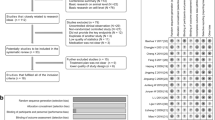Abstract
Thirteen patients with resectable lung cancer and concomitant malignant pleurisy which could not be detected by preoperative chest roentogenograms were treated with surgical resection of the primary lesions and postoperative intrapleural instillations of interleukin-2 (IL-2). All of the patients demonstrated disappearance of cancer cells from pleural effusion after the IL-2 therapy. Four of the 13 patients survived over 5 years and 2 of them are in disease free state at this moment (January 31, 1993). The first recurrent sites were distant organs in 8 of 11 patients with recurrence and lymph nodes in 3 of them. No pleural recurrence was observed. These results indicate that the postoperative intrapleural IL-2 therapy may be one of hopeful adjuvant therapies in patients with resectable lung cancer and concomitant malignant pleurisy, although distant metastasis and lymph node recurrence could not be suppressed completely.
Similar content being viewed by others
Abbreviations
- IL-2:
-
interleukin-2
- TIL:
-
tumor infiltrating lymphocyte
- LAK:
-
lymphokine activated killer
- TNF:
-
tumor necrosis factor
References
Rosenberg SA, Lotze MT, Muul LM, Leitman S, Change AE, Ettinghausen SE, Matory YL, Skibber JM, Shiloni E, Vetto JT, Seipp CA, Simpson CG, Reichert CM. Observation on the systemic administration of autologous lymphokine-activated killer cells and recombinant interleukin-2 to patients with metastatic cancer. N Engl J Med 1985; 313:1485–92.
Kradin RL, Boyle LA, Preffer FI, Callahan RJ, Barlai-Kovach M, Strauss HW, Dubinett S, Kurnick JT. Tumor-derived interleukin-2-dependent lymphocytes in adoptive immunotherapy of lung cancer. Cancer Immunol Immunother 1987; 24:76–85.
Belldegrun A, Kasid A, Uppenkamp M, Topalian SL, Rosenberg SA. Human tumor infiltrating lymphocytes; Analysis of lymphokine mRNA expression and relevance to cancer immunotherapy. J Immunol 1989; 142:4520–6.
Yasumoto K, Takeo S, Yano T, Nakahashi H, Nagashima A, Sugimachi K, Nomoto K. Role of tumor infiltrating lymphocytes in host defence mechanisms against lung cancer. J Surg Oncol 1988; 38:221–6.
Miescher S, Whiteside TL, Carrel S, von Fliedner W. Functional properties of tumor-inflicting and blood lymphocytes in patients with solid tumors; Effects of tumor cells and their supernatants on proliferative responses of lymphocytes. J Immunol 1986; 136:1899–907.
Mull LM, Spiess PJ, Director EP, Rosenberg SA. Identification of specific cytolytic immune responses against autologous tumor in humans bearing malignant melanoma. J Immunol 1987; 138:989–95.
Belldegrun A, Muul LM, Rosenberg SA. Interleukin-2-expanded tumor-infiltrating lymphocytes in human renal cell cancer; isolation, characterization, and antitumor activity. Cancer Res 1988; 48:206–14.
Heo DS, Whiteside TL, Johnson JT, Chen K, Barnes EL, Herberman RB. Long-term interleukin-2-dependent growth and cytotoxic activity of tumor-infiltrating lymphocytes from human squamous cell carcinomas of the head and neck Cancer Res 1987; 47:6353–62.
Yasumoto K, Miyazaki K, Nagashima A, Ishida T, Kuda T, Yano T, Sugimachi K, Nomoto K. Induction of lymphokine-activated killer cells by intrapleural instillations of recombinant interleukin-2 in patients with malignant pleurisy due to lung cancer. Cancer Res 1987; 47:2184–87.
Yasumoto K, Ogura T. Intrapleural application of recombinant interleukin-2 in patients with malignant pleurisy due to lung cancer. A multi-institutional cooperative study. Biother 1991; 3:345–9.
Mattews MJ, Kanhouwa S, Pickren J, Robinette D. Frequency of residual and metastatic tumor in patients undergoing curative surgical resection in lung cancer. Cancer Chemother Rep 1973; 4:63–7.
Paulson DL. The survival rate in superior sulcus tumors treated by presurgical irradiation. JAMA 1966; 4:342.
McKneally MF, Maver C, Lininger L, Kausel HW, McIlduff JB, Older TM, Foster ED, Alley RD. Four-year follow-up on the Albany experience with intrapleural BCG in lung cancer. J Thorac Cardiovasc Surg 1981; 81:485–92.
Yasumoto K, Yaita H, Ohta M, Azuma I, Nomoto K, Inokuchi K, Yamamura Y. Randomly controlled study of chemotherapy versus chemoimmunotherapy in post-operative lung cancer patients. Cancer Res 1985; 45:1413–7.
Fujisawa T, Yamaguchi Y, Kimura H, Arita M, Baba M, Shiba M. Adjuvant immunotherapy of primary resected lung cancer with transfer factor. Cancer 1984; 54:663–9.
Edwards FR, Whitewell F. Use of BCG as an immuno-stimulant in the surgical treatment of immunostimulant in the surgical treatment of carcinoma of lung-a five year follow-up report. Thorax 1978; 33:250–2.
Mountain CF, Gail MH. Surgical adjuvant intrapleural BCG treatment for stage I non-small cell lung cancer. Preliminary report of the National Cancer Institute Lung Cancer Study Group. J Thorac Cardiovasc Surg 1981; 82:649–57.
Ludwig Lung Cancer Study Group. Adverse effect of intrapleuralCorynebacterium parvum as adjuvant therapy in resected stage I and II non-small cell carcinoma of the lung. J Thorac Cardiovasc Surg 1985; 89:842–7.
Morgan DA, Ruscetti FW, Gallow R. Selective in vitro growth of T lymphocytes from normal human bone marrows. Science (Wash DC) 1976; 193:1007–8.
Baker PE, Gillis S, Ferm MM, Smith KA. The effect of T cell growth factor on the generation of cytolytic T cells. J Immunol 1982; 121:2168–73.
Henney CS, Kuribayashi K, Kern DE, Gillis S. Interleukin-2 augments natural killer cell activity. Nature (Lond) 1981; 291:335–8.
Lotze MT, Grimm EA, Mazumder A, Strausser JL, Rosenberg SA. Lysis of fresh and cultured autologous tumor by human lymphocytes cultured in T-cell growth factor. Cancer Res 1981; 41:4420–5.
Grimm EA, Mazumder A, Zhang HZ, Rosenberg SA. Lymphokine-activated killer cell phenomenon. Lysis of natural killer-resistant fresh solid tumor cells by interleukin-2-activated autologous human peripheral blood lymphocytes. J Exp Med 1982; 155:1823–41.
Rosenberg SA, Lotze MT, Yang JC, Aebersold PM, Linehan WM, Seipp CA, White DE. Experience with the use of high-dose interleukin-2 in the treatment of 652 cancer patients. Ann Surg 1989; 210:474–85.
Bindon C, Czerniecki M, Ruell P, Edwards A, McCarthy WH, Harris R, Hersey P. Clearance rates and systemic effects of intravenously administered interleukin-2 (IL-2) containing preparations in human subjects. Br J Cancer 1983; 47:123–33.
Author information
Authors and Affiliations
Rights and permissions
About this article
Cite this article
Yasumoto, K., Nagashima, A., Nakahashi, H. et al. Effect of postoperative intrapleural instillations of interleukin-2 in patients with malignant pleurisy due to lung cancer. Biotherapy 6, 133–138 (1993). https://doi.org/10.1007/BF01877426
Accepted:
Issue Date:
DOI: https://doi.org/10.1007/BF01877426




